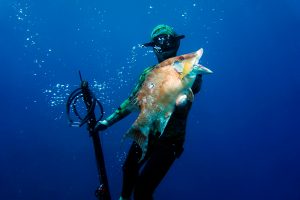Spearfishing inshore waters offers a unique combination of excitement and challenge, allowing you to engage closely with the marine environment while targeting some of the most sought-after species. Unlike traditional fishing, spearfishing requires stealth, precision, and knowledge of the local marine life. Here’s a guide to some of the best inshore species to target and tips to make your spearfishing adventure successful.
1. Understanding Inshore Spearfishing
Inshore spearfishing typically occurs in waters up to 60 feet deep, often around coastal reefs, rocky outcrops, and seagrass beds. These areas are rich in marine life and provide ideal habitats for various species.
Key Considerations:
- Water Visibility: Clear water is crucial for spotting and targeting fish. Check local conditions before heading out.
- Tides and Currents: Plan your dive around slack tide when the water is calmest, making it easier to approach your targets.
2. Top Inshore Species to Target
Here are some of the most popular and rewarding species to hunt while inshore spearfishing:
a. Snapper Snapper is a favorite among spearfishers due to its abundance and challenging nature. These fish are often found around reefs and rocky structures, where they use the environment for cover.
Tips for Targeting Snapper:
- Approach Quietly: Snapper are wary and can spook easily, so move slowly and avoid making sudden movements.
- Use the Right Gear: A medium-sized speargun or polespear is ideal for these agile fish.

b. Grouper Grouper are another prime target, known for their size and strength. They often inhabit deeper inshore reefs and ledges, making them a challenging but rewarding catch.
Tips for Targeting Grouper:
- Patience is Key: Grouper often hide in caves or crevices, so it may take some time to lure them out.
- Aim for Vital Areas: These fish are tough, so precise shots are essential to ensure a clean catch.
c. Flounder Flounder are flatfish that blend into sandy or muddy bottoms, offering a unique challenge for spearfishers. They are usually found in shallower waters, making them accessible for beginners.
Tips for Targeting Flounder:
- Scan the Bottom: Look for the outline of the fish against the sand, as they often bury themselves partially.
- Use a Light: A hand-held light can help you spot these well-camouflaged fish, especially in low-light conditions.
d. Sheepshead Sheepshead are known for their distinctive teeth and black-and-white striped bodies. They are often found around pilings, docks, and rocky shorelines.
Tips for Targeting Sheepshead:
- Focus on Structure: These fish are attracted to barnacle-covered structures where they feed.
- Short-Range Shots: Sheepshead often allow close approaches, so a shorter speargun or polespear works well.
3. Gear Up for Success
The right gear is essential for a successful spearfishing trip. Here’s what you’ll need:
Spearfishing Gear Essentials:
- Speargun or Polespear: Choose based on the species you’re targeting and the visibility of the water.
- Wetsuit: A camouflaged wetsuit can help you blend in with your surroundings.
- Mask and Snorkel: Ensure a comfortable fit for clear vision and easy breathing.
- Fins: Opt for long, flexible fins for efficient swimming.
- Weight Belt: Adjust your buoyancy to stay neutrally buoyant, making it easier to dive and stay submerged.
4. Spearfishing Etiquette and Conservation
Responsible spearfishing is crucial for maintaining healthy marine ecosystems. Follow these guidelines to ensure sustainable practices:
Conservation Tips:
- Take Only What You Need: Limit your catch to avoid overfishing.
- Respect Local Regulations: Be aware of size and bag limits, and avoid targeting protected species.
- Leave No Trace: Minimize your impact on the environment by avoiding damage to coral reefs and seagrass beds.
5. Final Thoughts: Preparing for the Dive
Before heading out, ensure you’re well-prepared:
- Dive with a Buddy: Safety is paramount in spearfishing. Always dive with a partner.
- Check Your Gear: Regularly maintain and inspect your gear to prevent malfunctions underwater.
- Stay Hydrated: Dehydration can lead to fatigue, so drink plenty of water before and after your dive.
Spearfishing for inshore species is an exhilarating way to connect with the ocean and test your hunting skills. By targeting these species and following best practices, you can enjoy a successful and sustainable spearfishing experience.
Image: fishingbooker





